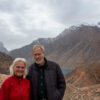04.01.2013 Turkey. Three years after a Syrian Orthodox foundation applied for permission to build a church in Istanbul, the Istanbul municipality has given them a large piece of land and a building permit. The Syrian Orthodox Church is one of the Oriental churches that, along with the Coptic, Armenian and Ethiopian churches, slipped out of communion with the majority of Christendom with the adoption in 451 of the dogma that Christ has two natures, one human and one divine. The Syriac Orthodox Church has preserved the Aramaic language, and many of its members still speak Aramaic in everyday life.
Major headlines in the Turkish media praised the decision as: "Unprecedented in the history of the republic" because Turkey has never before allowed a non-Muslim minority to build an officially recognized religious building.
Yet the Syrian Christians are far from satisfied. For one thing, the piece of land they were "given" is actually a Catholic cemetery. "We don't want a Syrian church on top of a cemetery!" the website www.suryaniler.com proclaimed. "It's a big scandal".
In fact, the cemetery was donated to the Catholic Church back in 1868 in what is now Istanbul's Yesilkoy district. It was subsequently registered as Catholic property in 1936, but was later confiscated by the city in 1951.
The Council of Europe's 2011 report shows that Turkey has not fully implemented Law No. 3998, which prevents local authorities from taking over cemeteries belonging to religious minorities. According to lawyer Nail Karakas, the Catholic foundation has submitted an application to regain possession of their property and resume Christian burials in the cemetery. They did so in accordance with the government's 2011 promise to return expropriated property to minority communities.
Therefore, the Syrian leaders insist that the cemetery they have been given to build their church on is instead returned to its rightful owners. "It's clear that the authorities want to create division between the minority churches," says Syrian layman Sabo Boyaci. He also blames the government for trying to exploit the Syrian community politically. "I don't think the government is sincere. They gave us this piece of land to silence us in the case of the Mor Gabriel monastery. They simply want to make a good impression on European and Turkish society," he told Hurriyet Daily News.
Monastery land under threat
EU officials have expressed "serious concerns" since the Turkish Supreme Court of Appeals issued its final verdict on November 15 against the 4th century Mor Gabriel Monastery. The court ruled that approximately 275 hectares of land belonging to the monastery built more than 1600 years ago near Mardin in the Tur Abdin region of eastern Turkey should be confiscated. The decision was labeled an "illegal expropriation" by the Council of Europe.
Five different cases over the ownership of the monastery's land have gone back and forth between the courts since 2008, when Muslim villagers in the area filed a complaint with the state finance and forestry office claiming that the monastery had illegally taken possession of their land.
The state then filed a lawsuit on the basis that the National Land Registry had been updated earlier in the year with new local boundaries and new laws had been introduced that made it legal to transfer "uncultivated land or forest areas" to state ownership.
"I know from experience that if some 'citizens' file a collective case against non-Muslims in Turkey, it is almost certain that the state has had a hand in it somehow," wrote columnist Orhan Kemal Cengiz on December 7 in Today's Zaman newspaper.
The lawsuit was openly supported by parliamentarian Suleyman Celebi, a member of the ruling Peace and Development Party. Celebi claimed that although the monastery's boundaries had been legally established back in the days of the Ottoman Empire, the Syrian Christians had not properly respected them.
According to a vice president of the monastery foundation, the monastery will take the case to the European Court of Human Rights if their appeal to the Constitutional Court is not successful.
The residence of the Syrian Orthodox Patriarch was in Midyat until 1930 when it was forced to move to Damascus, where it still stands. Mother Gabriel is the oldest surviving Syriac Orthodox monastery in the world and still keeps alive the ancient Aramaic language, which is the closest language to the one spoken by Jesus.
Around 2000 Syrian Christians still live in their original homeland in and around Mardin. More than 10,000 others have emigrated to Istanbul in recent decades. As they don't have their own official church, parishes in Istanbul have to rent Catholic churches around the city.
The Syrian Church of the Virgin Mary Foundation says that the church they plan to build must be able to accommodate at least 1000 worshippers.
Source: World Watch Monitor





